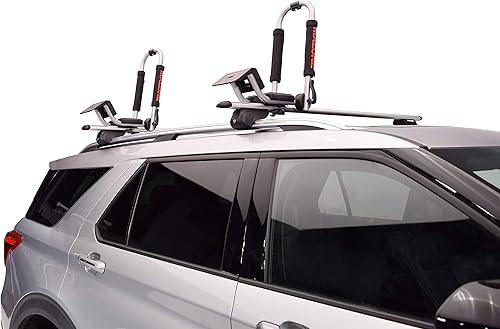Looking for the best kayak rack for Dodge Charger is not exactly straightforward, since you’re dealing with a sporty sedan that wasn’t built with hauling in mind. The trick is finding a rack that won’t scrape the roofline or mess with the car’s sleek look, while still gripping tight enough to make you feel safe driving highway speeds. After testing different setups and listening to owners who push their Chargers harder than most, the one that actually feels dependable and surprisingly hassle-free is the Malone Downloader 2-Pack Roof Rack. It balances security with easy loading, making it the top pick if you want a rack that doesn’t fight with the car’s design.
Best 5 Kayak Racks for Dodge Charger
01. Malone Downloader 2-Pack Roof Rack
The Malone Downloader 2-Pack Roof Rack is a solid choice for paddlers who need a J-Style kayak carrier that folds down when not in use. Built with heavy-duty aluminum frames and corrosion-resistant hardware, this roof rack system works on most crossbars including round, square, and factory bars. It comes with the SpeedLine™ load-assist system which makes strapping kayaks less of a hassle, especially when handling larger sit-on-top or touring kayaks. Perfect for SUVs, trucks, and sedans, this kit includes all tie-down straps so you don’t need to buy extras.
Pros:
- ✅ Strong build with corrosion-resistant hardware
- ✅ Universal fit for round, square, and factory crossbars
- ✅ Fold-down design for better garage clearance
- ✅ SpeedLine™ system makes strapping easier
- ✅ Includes bow & stern tie-downs for added security
Cons:
- ❌ Slightly heavier than some foldable kayak racks
- ❌ Installation can take longer the first time
- ❌ May create wind noise at highway speeds
02. FORWODE Premium Kayak Roof Rack
The FORWODE Premium Kayak Roof Rack is built for folks who want a secure way to transport their kayaks, canoes, or even paddle boards without stressing about stability on highways. With its heavy-duty steel frame, adjustable J-bar design, and padded contact points, it helps protect your boat from scratches during transport. It works with crossbars on SUVs, sedans, and trucks, giving it wide compatibility for outdoor trips.
Pros:
- ✅ Sturdy steel construction with rust-resistant coating
- ✅ Soft padding helps protect kayak hulls from damage
- ✅ Fits most crossbars and roof rack systems
- ✅ Easy folding design for storage when not in use
Cons:
- ❌ Might require tools and time for the first installation
- ❌ Not ideal for oversized tandem kayaks due to limited width
03. PIRIPARA Kayak Roof Rack
The PIRIPARA Kayak Roof Rack is a strong and foldable rack system built for hauling kayaks, canoes, surfboards, or paddle boards on vehicles like SUVs, trucks, and crossovers. Made from durable steel with padded bars and adjustable straps, it helps protect your boat while keeping it firmly in place during long highway drives or bumpy roads. Its folding J-bar design saves space when not in use, and it works with many crossbars, including round, square, and factory styles, making it practical for different vehicle setups.
Pros:
- ✅ Heavy-duty steel construction for stability and long use
- ✅ Soft padding to prevent scratches on kayak or SUP boards
- ✅ Folding design for easy storage and reduced wind drag
- ✅ Compatible with round, square, aero, and most factory crossbars
Cons:
- ❌ May require extra tightening for heavier canoes or tandem kayaks
- ❌ Installation can be tricky for beginners without prior rack setup
- ❌ Not ideal for vehicles with very short or low roof rails
04. Thule Compass Kayak Roof Rack
The Thule Compass Kayak Roof Rack is built for drivers who need one carrier that can handle both kayaks and SUP boards. It mounts securely on most crossbars and gives you flexible loading options whether you’re hauling a single kayak, two kayaks side-by-side, or paddleboards. With its padded design and sturdy frame, this rack protects your gear from scratches and keeps everything tight during highway trips or rough backroads. Outdoor enthusiasts who own a Chevy Traverse, Ford F150, or even smaller sedans with roof rails will find it useful for regular weekend water runs.
Pros:
- ✅ Can hold 1 kayak, 2 kayaks, or up to 2 SUPs
- ✅ Thick padding for hull and board protection
- ✅ Universal fit on most crossbars (round, square, aero)
- ✅ Easy fold-down design when not in use
Cons:
- ❌ Premium price compared to budget carriers
- ❌ Heavy gear setup may require two people to load
- ❌ Not ideal for vehicles without roof rails or crossbars
05. Taelakeni 2 Pairs Kayak Carrier Racks
The Taelakeni 2 Pairs Kayak Carrier Racks are a practical option for paddlers who want a solid roof rack solution for carrying multiple kayaks. Built with a J-style design, these racks fit most crossbars including round, square, oval, and flat styles, making them versatile for SUVs, trucks, and cars. The heavy-duty steel frame with adjustable padding helps protect your kayak hull from scratches, while the foldable feature makes it easy to store when not in use. Perfect for kayak transportation, canoe hauling, and even paddleboard loading.
✅ Pros
- ✅ Compatible with most factory and aftermarket crossbars
- ✅ Sturdy steel frame with protective foam padding
- ✅ Foldable design saves space when racks are not used
- ✅ Carries up to 2 kayaks with secure straps included
❌ Cons
- ❌ Assembly may take longer for first-time users
- ❌ Not as aerodynamic as saddle-style racks at higher speeds
- ❌ May require stronger crossbars for heavier loads
How to Choose The Best Kayak Racks for Dodge Charger
People raise eyebrows when you say you’re strapping a kayak rack to a Dodge Charger. It’s a muscle car, a road beast, not exactly the poster child for hauling long plastic boats. But life doesn’t really care about stereotypes. If you own a Charger and you paddle, you’re going to figure out a way to carry your kayak, no matter how odd the pairing looks parked at the lake.
The roof isn’t flat, and that changes everything
Unlike SUVs with big flat tops, the Charger has a sloped roofline that curves just enough to make racks tricky. Standard crossbars don’t always sit right. You’ll need a fit kit that hugs the edges without chewing up the paint. Companies like Thule and Yakima make vehicle-specific clips because suction cups or universal straps don’t cut it on a car that can hit 130 mph without breaking a sweat.
Fun fact: average kayaks weigh between 35 to 80 pounds. Add crossbars, racks, tie-downs, and you’re stacking almost 100 pounds on a roof not designed for heavy loads. That’s why the factory weight rating for many sedans, including the Charger, is usually capped around 120 to 150 pounds. Go beyond that, and the metal flexes. You’ll know because the doors start closing funny.
Foam blocks, J-cradles, saddles, and the endless debate
Some paddlers swear by foam block carriers because they’re cheap and simple. Throw them on the roof, strap the kayak down, and go. But on a Charger? That’s flirting with scratches, dented roof metal, and straps whistling so loud you’ll think you’re being chased by a ghost at 70 mph.
Then you’ve got J-cradles. They tilt the kayak on its side, saving roof space, and work better for multiple boats. Downside? Extra wind drag. Saddles and rollers let you slide the kayak up from the back, which is handy if you’re short or tired after paddling. A Charger’s trunk is long though, so lining up rollers sometimes feels awkward—unless you’ve got arms like a crane.
Security, or how to avoid theft in the parking lot
Kayaks aren’t cheap. Racks aren’t cheap either. An unguarded system is basically a gift to anyone with a wrench. Quality racks usually come with lock cores or at least spots for padlocks. Considering the average kayak costs $500 to $1,500, plus another $200–$500 for racks and crossbars, a lock is not optional. Especially if you’re parking at trailheads or public beaches where people wander around with too much time.
Wind noise, gas mileage
Here’s the unsexy part: racks change how your Charger feels. Even empty, crossbars make a hum at highway speeds. With a kayak on top, drag increases enough that your MPG can drop by 10–20%, depending on speed and distance. A 300-mile road trip to a lake could mean an extra half tank burned just from carrying the boat. Some people shrug it off, others fume when they see the needle dropping faster than usual.
Installation, the do-it-yourself headache
Installing racks isn’t always complicated, but Chargers weren’t designed for roof racks by default. That means you’re looking at aftermarket crossbars with fit kits that clamp into the door frames. One slip and you gouge the paint. Most kits take about 30–45 minutes to install once you know what you’re doing, but the first time feels like wrestling with metal brackets that don’t want to line up.
Personal bias sneaking in
If I had to pick, I’d say J-cradles make the most sense for a Charger. They hold the kayak firmly, keep it from sliding, and don’t put as much flat weight on the roof compared to saddles. But that’s me—other folks will argue foam blocks are fine if you pad them right. I once saw a Charger hauling two 12-foot kayaks with nothing but pool noodles under them. Looked terrifying, but somehow they made it to the lake without losing one. Doesn’t mean it’s smart though.
Quick mental checklist before buying
- Check roof weight rating of the Charger (don’t overload it).
- Decide between foam blocks, J-cradles, saddles, or rollers.
- Look for locking systems—racks and boats.
- Factor in wind noise and fuel cost.
- Buy a proper fit kit made for the Charger’s roof.
- Practice loading before your first long trip, so you’re not swearing in a parking lot while strangers watch.
Closing thought
The Dodge Charger wasn’t built to haul kayaks, but it can. Picking the right rack is less about perfection and more about compromise: security vs noise, budget vs convenience, paint protection vs laziness. You’ll curse a little the first time you mount everything, maybe second-guess the money you spent, but once you’re at the water with your kayak still strapped tight, it feels worth the hassle.






